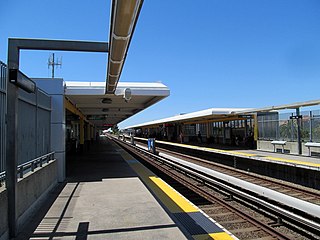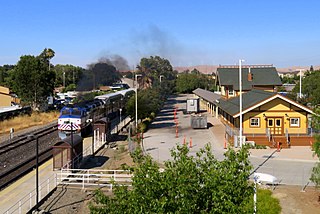
The San Joaquins is a passenger train service operated by Amtrak in California's San Joaquin Valley. Seven daily round trips run between its southern terminus at Bakersfield and Stockton, with onward service to Sacramento and Oakland. For Fiscal year 2025, two additional trips to Sacramento will be added.

The Altamont Corridor Express is a commuter rail service in California, connecting Stockton and San Jose during peak hours only. ACE is named for the Altamont Pass, through which it runs. Service is managed by the San Joaquin Regional Rail Commission, and operations are contracted to Herzog Transit Services. The 86-mile (138 km) route includes ten stops, with travel time about 2 hours and 12 minutes end-to-end. In 2023, the line had a ridership of 576,300, or about 3,000 per weekday as of the second quarter of 2024. ACE uses Bombardier BiLevel Coaches, MPI F40PH-3C locomotives, and Siemens Charger locomotives.

Union City station is a Bay Area Rapid Transit (BART) station in Union City, California. The station sits near Decoto Road east of Alvarado-Niles Road, directly behind the James Logan High School campus. The station is served by the Orange and Green lines. Local bus service is provided by Union City Transit and AC Transit.

Emeryville station is an Amtrak station in Emeryville, California, United States. The station is served by the California Zephyr, Capitol Corridor, Coast Starlight, and San Joaquins. The station is the primary connection point for Amtrak Thruway buses serving San Francisco.

Santa Clara Transit Center is a railway station in downtown Santa Clara, California. It is served by Caltrain, Amtrak Capitol Corridor, and Altamont Corridor Express (ACE) trains. It is the planned terminus for the Silicon Valley BART extension into Santa Clara County on the future Green and Orange Lines. The former station building, constructed in 1863 by the San Francisco and San Jose Railroad, is used by the Edward Peterman Museum of Railroad History.

Martinez station is an Amtrak passenger train station in Martinez, California, United States. Located at the west end of downtown Martinez, the station has one side platform and one island platform, which serve three of the four tracks of the Union Pacific Railroad Martinez Subdivision. It is served by the daily California Zephyr and Coast Starlight long-distance trains, five daily round trips of the San Joaquin corridor service, and fifteen daily round trips of the Capitol Corridor service. Martinez is also served by Amtrak Thruway buses plus County Connection, Tri-Delta Transit, and WestCAT local buses.

San Joaquin Street station, also known as Stockton – San Joaquin Street, is an Amtrak station in Stockton, California. Originally built for the Atchison, Topeka and Santa Fe Railway, it is a stop for trains on Amtrak's San Joaquin line between Oakland and Bakersfield. The Mission Revival style building cost $24,470 to construct, and includes typical design features such as stuccoed walls, a red tile roof and shady arcades.

City College station is an at-grade light rail station on the Blue Line of the SacRT light rail system operated by the Sacramento Regional Transit District. The station is located in an exclusive right of way alongside the Union Pacific Railroad's Sacramento Subdivision and a small rail yard, on the campus of Sacramento City College, after which the station is named, in the city of Sacramento, California.

Livermore is a train station in downtown Livermore, California.

Tracy station is a commuter rail station in southern Tracy, California served by the Altamont Corridor Express. It is on the Union Pacific Railroad Oakland Subdivision, formerly the Western Pacific Railroad.

Robert J. Cabral Station, is a railway station in Stockton, California. In 2003, the station building was named in honor of the late Robert J. Cabral, a San Joaquin County supervisor instrumental in the creation of the Altamont Corridor Express (ACE), originally Altamont Commuter Express.
Throughout the history of Bay Area Rapid Transit, there have been plans to extend service to other areas.
Merced station is a proposed California High-Speed Rail station in Merced, California, located in Downtown Merced. The originally proposed site was to have been located at ground level on Martin Luther King Jr. Way near the interchange with Route 99/59, placing it about 7 blocks south from the existing Merced Amtrak station. The station was initially intended to be the northern terminus of the system's Initial Construction Segment. An alternative location for a fully elevated station proposed by the City of Merced and other stakeholders, 8 blocks to the west-northwest along 15th Street, between O Street and R Street was approved after a supplemental environmental review. The high-speed rail line will run on the south side of the Union Pacific Railroad right-of-way.

Valley Link is a proposed 26-mile-long (42 km) commuter rail service in Northern California, which seeks to connect the rapid transit Bay Area Rapid Transit (BART) system in the San Francisco Bay Area with the northern San Joaquin Valley via the Tri-Valley region. Since 1997, BART's Blue Line's eastern terminus is at Dublin/Pleasanton station on the border of Dublin and Pleasanton. Valley Link seeks to extend rail service east from here into the northern San Joaquin Valley over Altamont Pass and to help alleviate traffic congestion and reducing greenhouse gas emissions on Interstate 580 (I-580). The project resulted from various failed proposals to extend the Blue Line east to Livermore.
Midtown Sacramento is a planned train station in the neighborhood of the same name that will be a stop on Altamont Corridor Express and Amtrak California's San Joaquin services. To be constructed as part of the Valley Rail project, it was expected to open no later than 2023. By 2023, the opening date had slipped to 2026. The platform will run between P Street and the wye at S Street and be bisected by Q Street. SacRT light rail stations are located either three blocks to the east or west.
Old North Sacramento is a planned train station that will be a stop on Altamont Corridor Express and Amtrak California's San Joaquin services. The station is located near the intersection of El Monte Avenue and Acoma Street. To be constructed as part of the Valley Rail project, it is expected to open by 2029. The SacRT light rail Globe station is located nearby to the east.
The Sacramento Subdivision is a rail line owned and operated by the Union Pacific Railroad in the U.S. state of California. The line begins in Marysville as a continuation of the Canyon Subdivision at a junction with the Valley Subdivision, and travels south through the Central Valley to a junction with the Fresno Subdivision in Stockton. South of Downtown Sacramento, the SacRT light rail Blue Line runs adjacent to the right of way until a flyover near Consumnes River Boulevard. The route between Sacramento and Stockton hosts about 12 to 20 freight trains daily as of 2018. Additionally, the Amtrak Coast Starlight runs over the tracks between Marysville and Sacramento.
The Oakland Subdivision is a Union Pacific Railroad line in the U.S. state of California. It extends from Stockton in the east to Oakland, crossing the Diablo Range at Altamont Pass and traversing Niles Canyon. The line was originally built by the Western Pacific Railroad as the final Pacific leg of their Feather River Route — it was acquired by Union Pacific upon their purchase of Southern Pacific. For its length, the line largely parallels the route of the First transcontinental railroad, the Western Pacific Railroad (1862–1870), though the Subdivision was laid out decades after the Western Pacific.
The Fresno Subdivision is a railroad in California owned and operated by the Union Pacific Railroad. Mostly built by the Southern Pacific Railroad in the 1870s, the line traverses the San Joaquin Valley on a northwest to southeast alignment.

The Niles Subdivision is a Union Pacific railway line which runs from Oakland, California to Newark, California in the East Bay.















